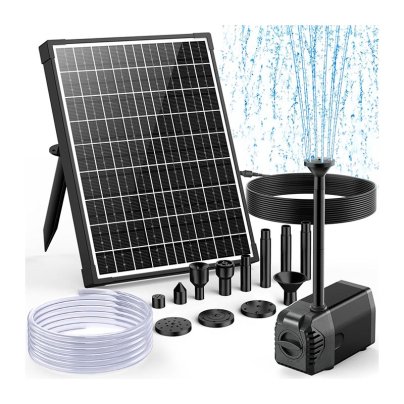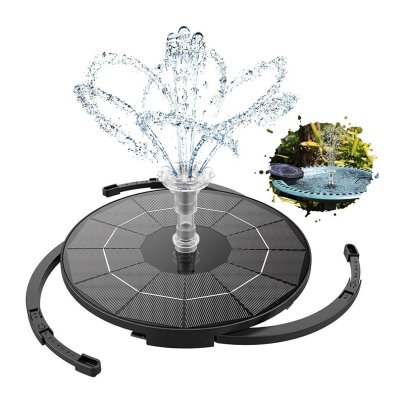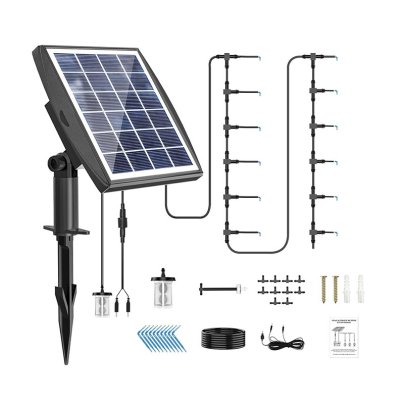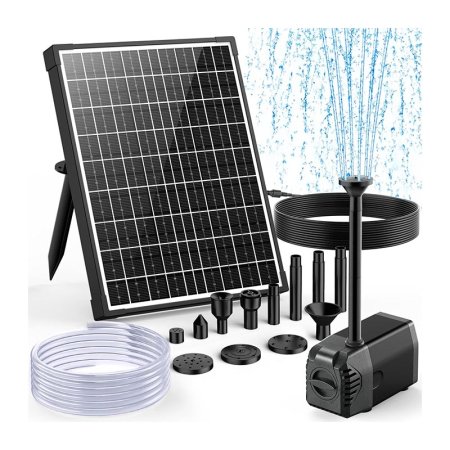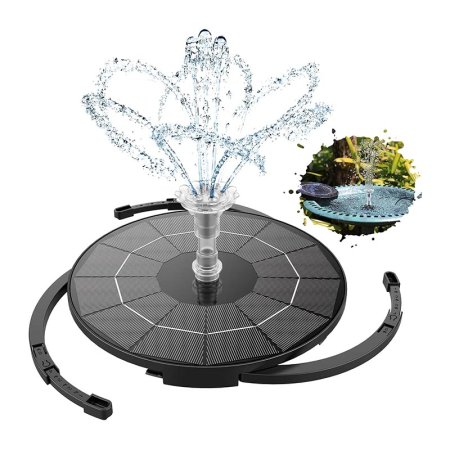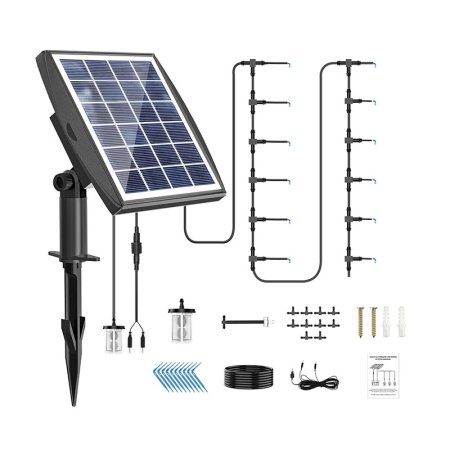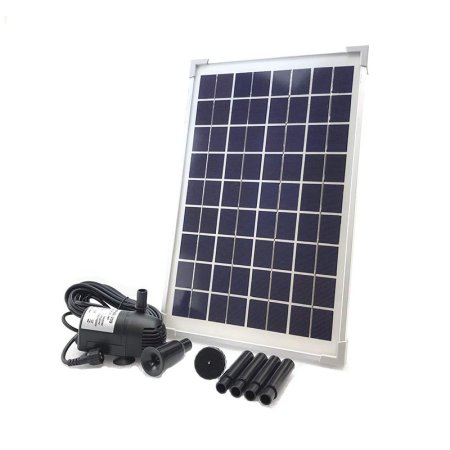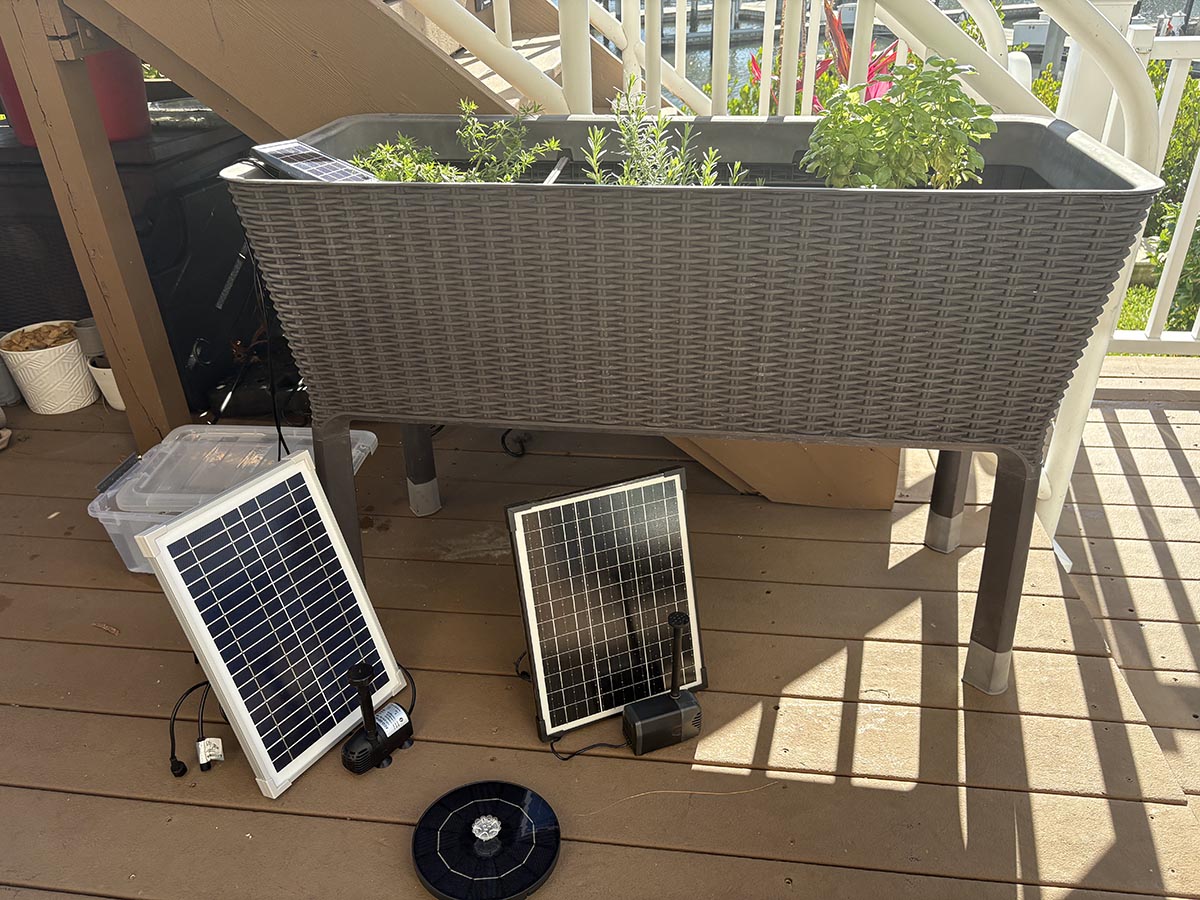
We may earn revenue from the products available on this page and participate in affiliate programs. Learn More ›
Solar-powered water pumps harness energy from the sun to efficiently move water from wells, storage tanks, ponds, or other sources to where it’s needed. Ideal for irrigation, birdbaths, ponds, and off-grid applications, these pumps provide a sustainable alternative to traditional electric or gas-powered models. Because they rely on renewable energy, they help reduce greenhouse gas emissions and lower electricity costs. They also offer easy installation without the need for extensive wiring.
To help narrow down the options, we tested several top-performing solar-powered water pumps, evaluating them for flow rate, durability, ease of installation, and overall efficiency. Our winning recommendation is the Poposoap Solar Fountain Pump, which stands out for its powerful performance, reliable solar panel, and versatility for multiple applications.
In this guide, we’ll walk you through key shopping considerations—such as pump type, power output, and installation requirements—to help you find the best solar-powered water pump for your outdoor needs.
- BEST OVERALL: Poposoap Solar Fountain Pump
↓ Jump to Review - BEST BANG FOR THE BUCK: Aisitin Solar Fountain Pump
↓ Jump to Review - BEST FOR IRRIGATION: Jiyang Automatic Solar Drip Irrigation Kit
↓ Jump to Review - TALLEST SPRAYER: AEO Solar Water Pump Kit
↓ Jump to Review
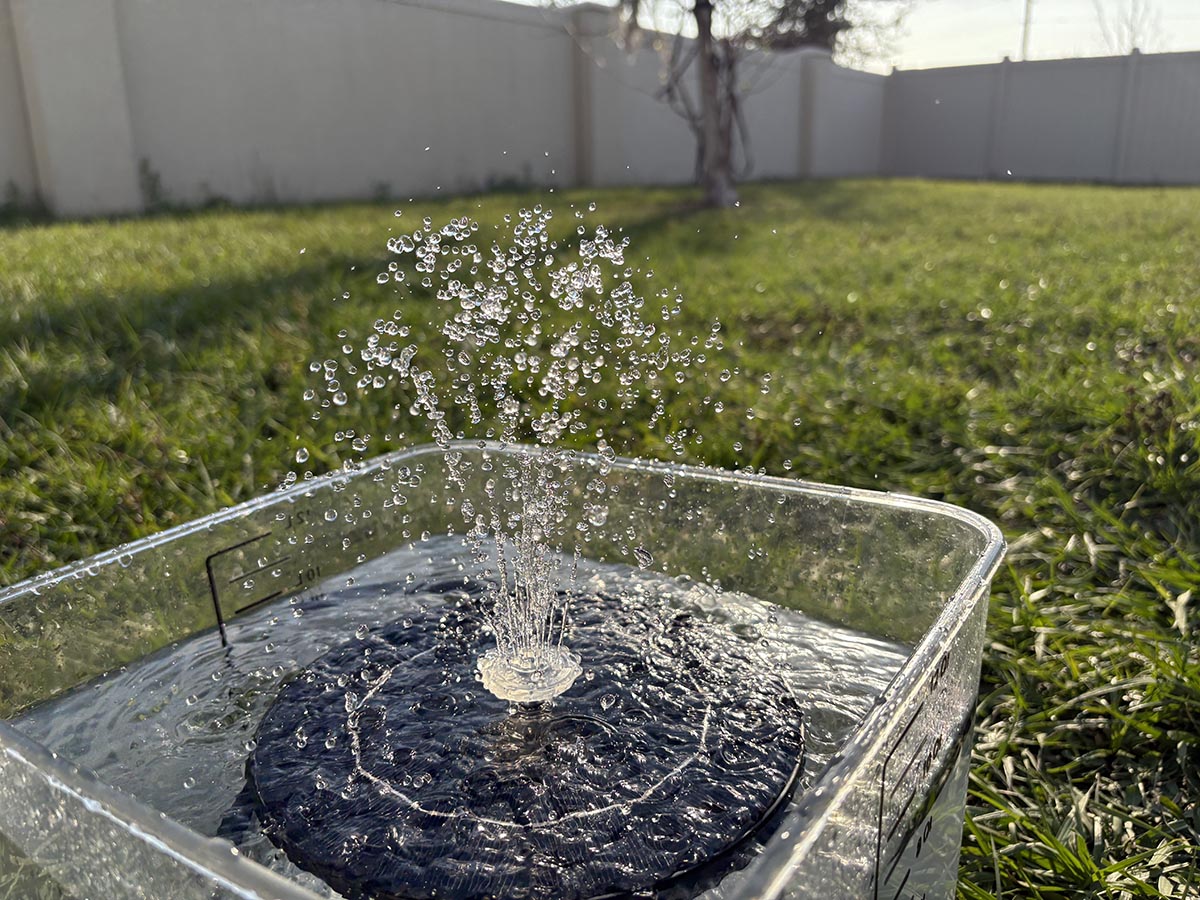
Solar-Powered Water Pumps Comparison Chart
| Product | Voltage | Max vertical head | Max flow rate | Dry run protection |
|---|---|---|---|---|
| Poposoap Solar Fountain Pump | 18 volts | 7.5 feet | 320 GPH | Yes |
| Aisitin Solar Fountain Pump | 6 volts | 24 inches | 64.7 GPH | No |
| Jiyang Automatic Solar Drip Irrigation Kit | Not stated | N/A | 6.3 GPH | Yes |
| AEO Solar Water Pump Kit | 18 volts | 5.6 feet | 186 GPH | No |
Our Top Picks
Finding the right solar-powered water pump can make a big difference in efficiency and reliability. We’ve researched and tested top models to help you choose the best options for irrigation, ponds, and more, ensuring durability, performance, and ease of use.
Best Overall
Poposoap Solar Fountain Pump
What We Like
- Best water height that we tested
- Plenty of nozzles to choose from
- Also comes with a water hose
- Option for backup battery (sold separately)
What We Don’t Like
- No dry run protection
Specs
- Voltage 18 volts
- Max lift height 7.5 feet
- Max flow rate 320 GPH
- Dry run protection Yes
Our Ratings
| Setup | 5/5 | Functionality | 5/5 | Durability | 5/5 | Value | 5/5 |
The Poposoap solar fountain pump stands out for its impressive power and versatility. Among the models we tested, it had the most powerful motor, producing a strong and consistent spray. Unlike some competitors, this one’s adjustable pump power actually makes a noticeable difference—you can use the lowest setting for a gentle effect or crank it up for a dramatic fountain display. It comes with seven sprayer nozzles, allowing you to customize the water pattern, and the adjustable height adds even more flexibility.
One unique feature is the inclusion of replacement pump filters. They are just simple sponge filters, but it’s still a thoughtful addition that makes long-term maintenance easier. It also includes a 6.6-foot water pipe, making it adaptable for larger water installations like tiered fountains. Like other solar-powered models, it works best in direct sunlight but still functions to some degree in partial sun or cloudy conditions. The manual notes that you can hook it up to a backup battery (not included) if you need continuous operation.
The main downside is the lack of dry run protection, meaning it could burn out if the water level drops too low. Additionally, it’s slightly more expensive than other models, but the powerful motor, extra accessories, and thoughtful design justify the price. For those looking for a high-performance solar-powered fountain, this is a solid choice.
What our tester says: “This one really produces a powerful spray that will look great in any outdoor water feature. I loved the simple setup and the wide range of nozzles to choose from.”—Paul Rankin, Product Reviews writer and tester
Get the Poposoap solar-powered pond pump at Amazon or Poposoap.
Best Bang for the Buck
Aisitin Solar Fountain Pump
What We Like
- Simple to use (throw it in the water)
- Multiple nozzles to choose from
- Adjustable arms for stability
What We Don’t Like
- Relatively weak power
Specs
- Voltage 6 volts
- Max lift height 24 inches
- Max flow rate 64.7 GPH
- Dry run protection No
Our Ratings
| Setup | 5/5 | Functionality | 3.5/5 | Durability | 4.5/5 | Value | 4.7/5 |
The Aisitin solar fountain pump is as simple as it gets—just drop it in the water, and as long as there’s sunlight, it will start spraying instantly. It’s a fun, no-fuss option for adding a little movement to a pond, birdbath, or small water feature. Kids could even play with it in a pool. The pump comes with several spray nozzles, each creating a unique water pattern, including some that spin for a dynamic effect.
One useful feature is the inclusion of extendable legs, which make it easy to keep the pump in place. You can adjust their length by pulling them in or out, which is a nice touch for those who want a bit more control over placement. There’s also a lever to adjust pump strength, but in testing, it didn’t make much difference—the full setting isn’t particularly powerful, and the lowest setting barely produces a spray. Note that this was tested in the Florida sunshine, so it got as much sunlight power as you’re ever likely to get.
This isn’t a high-powered fountain, nor is it meant to be. It’s a cheap, easy way to add a bit of life to a body of water, and for that purpose, it does the job well. If you’re looking for a simple, affordable solar fountain pump, this is worth a look.
What our tester says: “This small fountain pump is a nice bit of fun. Chuck it into some water and watch it spit out a cute little spray. There are loads of nozzles for different patterns, and could not be simpler to use.”—Paul Rankin, Product Reviews writer and tester
Get the Aisitin solar water pump at Amazon or Walmart.
Best for Irrigation
Jiyang Automatic Solar Drip Irrigation Kit
What We Like
- Simple enough to set up
- Can support 10 to 30 pots
- 6 automatic timing modes
What We Don’t Like
- Beeps quite loudly when the water runs out
Specs
- Voltage Not stated
- Max lift height N/A
- Max flow rate 6.3 GPH
- Dry run protection Yes
Our Ratings
| Setup | 5/5 | Functionality | 5/5 | Durability | 5/5 | Value | 5/5 |
The Jiyang automatic solar drip irrigation kit is a fun and practical gardening project that doesn’t take much time or effort to set up. The instructions are clear, and the kit includes plenty of hosing to customize the setup to your specific planter or garden bed. We tested it in a small herb planter, and it worked perfectly, delivering consistent watering without any hassle.
With three automatic watering durations (5, 15, or 20 minutes) that can be scheduled every 12 or 24 hours, it’s easy to keep plants hydrated without constant monitoring. The controls are simple—just an On/Off button and one to cycle through watering schedules—making it beginner-friendly. The small pump needs to be placed in a water container like a bucket, and the two included diodes help detect if the water level runs too low. When the water runs out, the pump will beep twice every couple of minutes (which may get annoying to your neighbors, so you may need to keep on top of the water levels).
In full sun, the solar panel powers the system effortlessly, making it a great low-maintenance solution for keeping plants healthy. It’s a great option for gardeners looking for an eco-friendly, hands-off watering system, especially in sunny climates.
Get the Jiyang solar-powered water pump at Amazon.
Tallest Sprayer
AEO Solar Water Pump Kit
What We Like
- Adjustable spray height
- Motor is easy to clean and maintain
- Setup could not be easier
What We Don’t Like
- Only 2 sprayer options
- No dry run protection
Specs
- Voltage 18 volts
- Max lift height 5.6 feet
- Max flow rate 186 GPH
- Dry run protection No
Our Ratings
| Setup | 5/5 | Functionality | 4.9/5 | Durability | 5/5 | 5/5 | Value | 5/5 |
The AEO solar water fountain pump kit is a straightforward, no-frills setup that delivers a surprisingly strong water spray when placed in full sunlight. The decent-sized solar panel comes with a stake for easy positioning, and as long as it’s in direct sunlight, the pump instantly kicks into action. Just drop the pump into water, connect it to the panel, and you’re good to go—no complicated setup required.
This kit includes two nozzle options: one for a traditional fountain effect and another that sprays water in a wide disc pattern. You can also adjust the spray height by connecting as many of the four tubes as you need. Performance is entirely dependent on sunlight—even a small shadow on the panel can shut it off—so for consistent operation, it needs to be in direct full sun.
If you’re looking for a simple, reliable solar water pump with a strong spray, this is a great choice. Just keep in mind that it only works when the sun is shining—there’s no battery backup for cloudy days or shaded areas.
Get the AEO solar-powered water pump at Amazon or Walmart.
Jump to Our Top Picks
How We Chose and Tested the Best Solar-Powered Water Pumps
| Testing Stats | |
|---|---|
| Products tested | 3 |
| Time spent testing | 2 weeks |
| Tests performed | 4 to 5 |
| Price range | $20 to $80 |
To determine the best solar-powered water pumps, we tested three different models over the course of two weeks, evaluating performance, durability, ease of use, and maintenance. Our goal was to find pumps that could operate reliably for extended periods and produce strong, consistent water flow, as well as being easy to install and maintain.
We placed each pump in direct sunlight and tested in different conditions, including full sun, partial sun, and shade, to gauge how well they performed. We measured spray height and consistency, noting any significant drops in performance under less-than-ideal lighting conditions.
After testing daily operation, we cleaned each pump and filter according to the manufacturer’s instructions, assessing how easy they were to maintain. We also considered extra features like nozzle variety, adjustable settings, and the ability to connect to external water sources. These evaluations helped us determine which models provided the best balance of power, usability, and value.
| Product | Setup | Functionality | Durability | Value |
| Poposoap Solar Fountain Pump | 5/5 | 5/5 | 5/5 | 5/5 |
| Aisitin Solar Fountain Pump | 5/5 | 3.5/5 | 4.5/5 | 4.7/5 |
| Jiyang Automatic Solar Drip Irrigation Kit | 5/5 | 5/5 | 5/5 | 5/5 |
What to Consider When Choosing a Solar-Powered Water Pump
When choosing a solar water pump, consider the type of pump you’ll need (surface or submersible), how much water will be moved, and how far it will travel from the water source. Other factors to think about include the size of the system, solar panel wattage, and the maximum flow rate of the pump.
Types of Solar-Powered Water Pumps
Designed to be placed at the water level, surface pumps are versatile units that can be used for things like irrigation, shallow ponds, or flooded basements. The surface pump draws in water from the source on one side and discharges it to the desired location on the other side.
Submersible pumps work best when entirely submerged and are used in wells and deeper water features. Once activated, the pump will suck water through a network of pipes or tubes before delivering it to the destination.
It’s important that both types be placed within the limits of max vertical head (MVH) because pump lift capabilities are reduced at higher altitudes. Additionally, dry run protection is an important feature for both types to avoid damage to the solar water pump shaft and other internal components.
Max Vertical Head
The max vertical head (MVH) is the maximum height that water can reach when pumped from the source. It’s an important consideration because the water pump is placed on the bottom of the water source, so you’ll need to make sure the pump is capable of moving water all the way to the surface. For example, if your fish pond is 4 feet deep and the max head of the pump is 3 feet, then the pump will not be able to lift enough water for your application.
Max Flow
The max flow (MF) capacity is how much water the pump can move in a certain amount of time. Most pumps list their maximum flow rate capacity in gallons per hour (GPH) or minute (GPM). If the max flow is too low, filling a tank or watering a backyard might take significantly longer than expected.
Solar Panels and Inverters
The solar panels used in water pump systems produce electricity using photovoltaics (PVs). The photovoltaic effect takes place when sunlight hits a material and creates an electrical current. Placing the solar panel in a location that receives significant sunlight is crucial to ensuring that the pump can run efficiently and produce maximum power.
Additionally, the more powerful pumps will need higher-watt solar panels in order to keep their batteries fully charged. Sizeable solar systems also require higher-voltage inverters to produce more AC power. This is important for applications requiring larger volumes of water, such as deep wells or large ponds. When choosing a solar inverter, it’s essential to select one that’s compatible with the output of the solar panel.
Batteries
Some solar-powered water pumps (typically, smaller ones) only function while being exposed to sunlight, while others can utilize batteries to store energy for longer, offering overnight pumping in some cases. For people residing in overcast regions, it’s highly recommended to have a backup battery. In addition, a charge controller can help prevent batteries from being overcharged or damaged.
Power Types For Water Pumps
Solar pumps run on two different types of power: direct current (DC) and alternating current (AC).
DC power is inexpensive and commonly used for more humble uses, like bird baths and solar water pumps for fountains. Although a higher-watt solar panel can connect directly to a DC-powered pump without the need for a solar controller, it’s not recommended due to possible power surges. Typically, DC pumps are sold as a complete unit that includes a solar panel, water pump, and necessary hoses. They’re also easy to set up and are the most common type of water pump.
On the other hand, AC-powered pumps are ideal for agriculture or industrial applications because they often provide a much higher flow rate than DC water pumps. They’re also especially useful in scenarios when emergency pumping is needed and grid power is available. However, one drawback is that inverters are necessary to operate AC water pumps, which adds to the overall cost. In addition, when an inverter converts the direct current generated by a solar panel to an alternating current, some energy is lost in the process.
Size of Water System for Agriculture Uses
When sizing a solar water system for livestock or crops, it’s essential to consider how much water is needed per day. Water demand is expressed in either gallons per day (GPD) or liters (LPD). In most cases, it’s best to have 3 or 4 days’ worth of stored water to account for extended cloudy conditions.
Warmer weather can also impact the output of your system. The optimal temperature for solar panel efficiency is around 77 degrees, so the energy output actually decreases in higher temperatures.
FAQs
Here are some frequently asked questions about solar-powered water pumps. We’ve gathered answers to help you understand how these pumps work, how to maintain them, and what to look for when choosing the best one for your needs. Whether you’re looking to power a fountain, irrigation system, or another water feature, these FAQs cover the most common concerns.
Some solar water pumps can move up to 10,000 gallons per day. The max flow will depend on pump size, the amount of sunlight the panel receives, and whether the system has battery backup.
A solar water pumping system comes in a wide range of prices, from around $20 for a small water fountain pump to well over $1,000 for deep well submersibles or irrigation pumps. The cost will depend on the size and power of the pump, the manufacturer, and the price of additional accessories you may need.
The short answer is yes, you can buy used solar water pumps. However, it’s essential to do your research before buying to ensure you’re getting a quality product, and keep in mind that the warranties provided by the manufacturer may not carry over to used products.
Solar water pumps will work to a max depth of around 800 to 1,000 feet.
Installation will vary depending on the type of water pump, but setups like bird baths and fountains are fairly simple DIY projects. Silicon Solar offers several guides and video tutorials to assist with basic installation of these water features.
No matter the pump type, solar panels should be installed facing south (in the Northern Hemisphere) to capture the most sunlight. If you’re not mounting the solar panel to a structure, you may have to create a mount by digging a hole and pouring concrete.
If you’re installing a submersible pump in a well, you’ll need to connect a solar controller to the panels. Once you’ve connected the wiring and piping to the pump and submerged it, connect the wiring to the solar system. Each product will require slightly different setups, but most manufacturers will provide installation guides.
When water pumps reach the end of their product life, there are several resources that can assist with recycling and waste management. For example, some Habitat for Humanity Restore shops will accept plastics and motors for repurposing. Recycle Nation offers a searchable database to find recycling centers in your area.
Batteries are recyclable, but should not be placed in home recycling bins. Both The Home Depot and Lowe’s offer battery recycling drop boxes in most store locations.
Solar panel recycling companies are emerging as an option for those with end-of-life panels and other solar equipment, including PV panels, batteries, inverters, and mounts.
Meet the Tester
Paul Rankin is an experienced product reviewer with a focus on outdoor and garden equipment. He provides clear, thorough reviews based on extensive testing and practical usage to help readers make informed, confident purchases.
Additional research provided by J.G.Wall.
